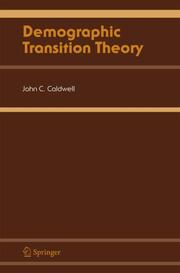-
Zusatztext
-
InhaltsangabeFrom the contents: Preface.- Introduction: Chapter 1: The Analytical Approach.- Part I: Issues of early transition.- Chapter 2: Pretransitional population control and equilibrium.- Chapter 3: Was there a Neolithic mortality crisis?.- Chapter 4: Population intensification theory.- Chapter 5: Wealth flows revisited.- Chapter 6: Fertility control in the classical world: was there an ancient fertility transition?.- Chapter 7: Family size control by infanticide in the great agrarian societies of Asia.- Part II: The Modern Transition.- Chapter 8: Transmuting the industrial revolution into mortality decline.- Chapter 9: The delayed Western fertility decline: an examination of English- speaking countries.- Chapter 10: Regional paths to fertility transition.- Chapter 11: The globalization of fertility behavior.- Chapter 12: Social upheaval and fertility decline.- Chapter 13: Demographic theory: a long view.- Chapter 14: Policy responses to low fertility and its consequences: a global survey.- Chapter 15: Explanation of the fertility crisis in modern societies: a search for commonalities.- Chapter 16: Back to the future: the great mortality crises.- Index.
-
-
Kurztext
-
The demographic transition is the change in the human condition from high mortality and high fertility to low mortality and low fertility. Death is now less capricious and most people live long lives. Women no longer average six or seven births but in most economically advanced countries less than two - insufficient to replenish national populations. Most of this dramatic social change has occurred over the last 150 years. But the question remains as to whether this is a completely new phenomenon or whether there has long been an inherent tendency in the human race to maximize survival and to control family size. This study addresses these issues. Part I addresses the situation among hunters and gatherers, traditional farmers and classical civilizations. Part II examines the modern transition, while an introductory chapter synthesizes the findings. An emphasis is placed upon the transmuting of the industrial revolution and rising incomes into longer lives and smaller families. Finally, explanations are sought for below-replacement fertility in Europe and elsewhere. The book has a strong theoretical focus and is unique in addressing both mortality and fertility over the full span of human history. It brings demographers to anthropology, anthropologists to demography, and both to social history.
-
-
Autorenportrait
- InhaltsangabeFrom the contents: Preface.- Introduction: Chapter 1: The Analytical Approach.- Part I: Issues of early transition.- Chapter 2: Pretransitional population control and equilibrium.- Chapter 3: Was there a Neolithic mortality crisis?.- Chapter 4: Population intensification theory.- Chapter 5: Wealth flows revisited.- Chapter 6: Fertility control in the classical world: was there an ancient fertility transition?.- Chapter 7: Family size control by infanticide in the great agrarian societies of Asia.- Part II: The Modern Transition.- Chapter 8: Transmuting the industrial revolution into mortality decline.- Chapter 9: The delayed Western fertility decline: an examination of English- speaking countries.- Chapter 10: Regional paths to fertility transition.- Chapter 11: The globalization of fertility behavior.- Chapter 12: Social upheaval and fertility decline.- Chapter 13: Demographic theory: a long view.- Chapter 14: Policy responses to low fertility and its consequences: a global survey.- Chapter 15: Explanation of the fertility crisis in modern societies: a search for commonalities.- Chapter 16: Back to the future: the great mortality crises.- Index.
Detailansicht
Demographic Transition Theory
Caldwell, John C/Caldwell, B K/Caldwell, P et al
ISBN/EAN: 9781402043734
Umbreit-Nr.: 1812589
Sprache:
Englisch
Umfang: viii, 404 S.
Format in cm:
Einband:
gebundenes Buch
Erschienen am 19.06.2006
Auflage: 1/2006


